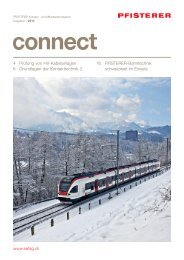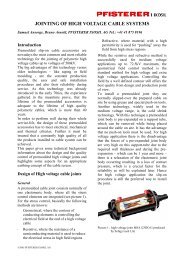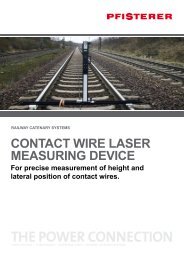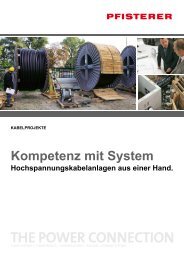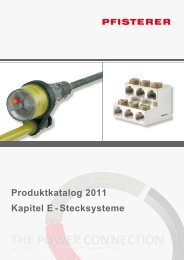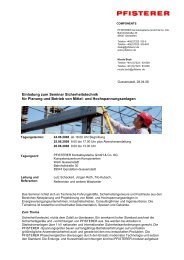Bending of helically twisted cables under variable ... - Pfisterer
Bending of helically twisted cables under variable ... - Pfisterer
Bending of helically twisted cables under variable ... - Pfisterer
Create successful ePaper yourself
Turn your PDF publications into a flip-book with our unique Google optimized e-Paper software.
This figure also shows the definition <strong>of</strong> the lay angle<br />
consideration, comprising <strong>of</strong> nL round round wires wires <strong>of</strong> the the same same diameter in the <strong>cables</strong> investigated here.<br />
Fig. 2.2 shows the components <strong>of</strong> an external force S tensioning a <strong>helically</strong> tw <strong>twisted</strong> isted cable, as they act on<br />
individual individual wires, wires, ignoring ignoring the transverse force, force, caused by by bending bending and torsion <strong>of</strong> the the wire (caused (caused by the<br />
external external tensile tensile force). force). This This transverse transverse force force is very small small because the lay lay angle and layer radii <strong>of</strong> the<br />
cable change very y little <strong>under</strong> tensile load [Feyrer, 1990].<br />
Fig. 2.2 Distribution <strong>of</strong> the tensile force to individual wires<br />
The wire tensioning force Zd,L in every individual wire <strong>of</strong> an arbitrary layer L<br />
<strong>of</strong> the cable is therefore:<br />
The total longitudinal tensile force in the cable is given by the sum:<br />
wires,layers<br />
where the summation also includes the core wire ( (βK = 0).<br />
In the determination <strong>of</strong> the tensile forces Z Zd,L in the individual wires, it is assumed that the cable<br />
cross-sections sections remain remain the the same same as as a a tensile tensile force force S, S, lengthening lengthening an an arbitrary arbitrary length length <strong>of</strong> <strong>of</strong> cable cable ℓs by ∆ℓs<br />
all the wires are in the linear-elastic elastic region, i.e. Hooke’s law law is applicable. Finally, the effects <strong>of</strong> the<br />
tangential force Ud,L are are assumed very very small. The The changes in the the lay angle angle and the transverse<br />
transverse<br />
contraction <strong>of</strong> the wire cross-sections sections are ne negligible in this context since the resultant stresses amount<br />
to to only only 1% 1% [CEA, [CEA, 1986] 1986] or or 2% 2% [Feyrer, [Feyrer, 1990] 1990] <strong>of</strong> <strong>of</strong> the the total total tensile stress in the the wire. The corresponding<br />
formulae are summarised in Annexure I.<br />
9<br />
the definition <strong>of</strong> the lay angle βL and the coil diameter dL <strong>of</strong> the layer <strong>under</strong><br />
and also lengthening the associated wire length ℓd,L by ∆ℓd,L, is applied. It is furthermore assu<br />
, is applied. It is furthermore assumed that



